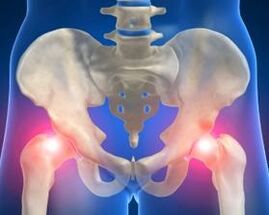
Hip joint arthrosis (coksartrosis) is a chronic disease, gradually developing, if there is no timely and timely treatment, it can lead to loss of complete movement in it.Finally shows that it is not an inflammation, but a degenerative process takes place.
The symptoms of the disease vary depending on the stage.Initially, this was an invisible discomfort during walking and physical training.It may be a manifestation in the form of poor pain in the thighs, which at rest.In this case, the pain can be felt not only in the thighs, but also in the thighs or knees.
As a rule, coxarthrosis is a leaking process for years, characterized by gradual changes in the cartilage, followed by bone deformation and loss of joint function.Most affect people after 40 years, but very young patients are also found.
Cause
Why does the hip joint arthrosis happen, and what is it?The causes of coxarthrosis can be different, but the picture of the disease is always the same.Everything begins with a change in the articular cartilage, which is thinner and the loss of property that offens the load.The body balances the stratification of cartilage tissue with the formation of bone growth along the edge of the articular surface, leading to different joint and bone deformation.
The main cause of this joint disease:
- Injury.This may not be the main lesion, but in many cases, chronic microtraumas affect the development of diseases that contribute to cracks and cartilage thinning.They also affect the sadness of the capsule together, leading to a lot of damage.Often recurrent microtraumas are pioneers of the appearance of such diseases.
- Excessive loadwhich leads to systematic microtrauma, as well as joint injury.Often, this is found in people involved in heavy physical labor or professional athletes.In this case, treatment without changing lifestyle or load restrictions is also ineffective and is often accompanied by relapse.
- Descendants.These include abnormalities in the development of the femoral head itself, the backwardness of the joint elements, and so on.In this case, dysplastic arthrosis coordinated with the hip joint occurs.
- Disease.For example, arthritis, without proper treatment, can decline into arthrosis over time.This is due to the fact that during arthritis of the nature of the change in cartilagin tissue, blood circulation disorders occur.Gradually, this leads to the development of degenerative processes.
- Excess weight.Excessive weight, even when walking, has a burden on the joints beyond their physiological strength.
Depending on the cause of the development of the disease and its pathogenesis, 2 main types of hip joint arthrosis are distinguished.
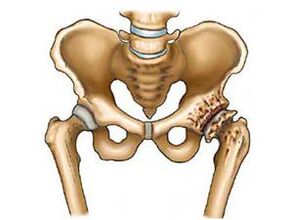
- The main coksartrosis.In this case, the disease develops very slowly and begins with the blood supply to the tissue.The cause of the development of this type of arthrosis is rooted as a violation of metabolism, which is more than 50 years old.The main arthrosis of the hip joint is most often diagnosed.
- Coksartrosis of the secondary.In this case, the disease develops with the background of the systemic inflammation of many joints in the body.Inflammation can be contagious and autoimmune.
In the early stages of the patient's coksartrosis, only a little pain or discomfort in the joint area is worried.Often such signs are ignored, as a result of the disease.
Symptoms of arthrosis of the hip joint
Coksartrosis of the hip joint, a symptom that cannot be ignored, can cause serious consequences.There are some basic signs of disease that depend on the level of the disease:
- Joint pain is the most obvious symptom in which TBS disease can be assumed.The intensity and nature of the sensation usually depend on the stage.
- Limiting the mobility of the limbs is also a symptom of coxarthrosis.For the early stages, the sensation of the "constraint" of the joints, which passes after the load, is characteristic.
- The weakness of the hip muscle can be observed in the second stage of the disease, reaching the third to solve the atrophy.
- Changing the length of the foot because the pelvic deformation is a feature of osteoarthritis "ignored".
- The paralysis or change of gait is a sign of bone deformation.
- Different deficiencies in the joints are far from always a sign of arthrosis.Usually taken into account if there are other symptoms.
The main features of coxarthrosis are pain, its nature, duration, localization and intensity depends on the level of the disease.
Arthrosis of the hip joint in the first stage
The level of the disease is characterized by pain in the joints and thighs, sometimes in the knee that occurs after physical activity and decreases after rest.Joint mobility is unlimited and there is no gait violation.
The first degree coksartrosis is the early stage of the disease, by starting the treatment, you can still stop the process of destruction and deformation of the joints and maintain its function.But, unfortunately, many do not think it should see a doctor because of the weak pain in the joints, and the disease, meanwhile, develops.
2 -degree hip arthrosis
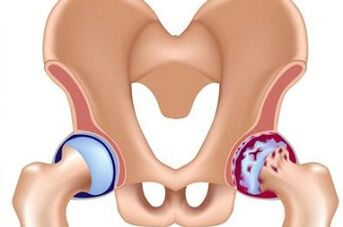
It shows itself more clearly - the intensity of pain grows, it occurs not only after the load, but also rest, there is a limit to motor function.In particular, coksartrosis is characterized by difficulty in performing the pronunciation (rotation of the thighs) and abduction, contraction is formed.
In the X -ray exam, we see the narrowing of the articular space and appearance on the surface of the bone growth.The swivel cavity and the femoral head are defective.Muscles -The thighs on the wound begin to atrophy, and the pain syndrome spreads below, capturing both knee joints and inguinal region (important to understand that this will not be accompanied by dystrophic changes in the knee joint).
3 -degree hip arthrosis
The signs of the disease are pronounced and fixed.Pain syndrome occurs at night.When walking, the patient uses support.The lower leg and hip muscles gradually atrophy, and the sick feet of the sick become very short.
Often, up to the 3rd level, the joint gap is completely lost, and the joints grow together into a bone structure, this shows the picture.As a result, complete immobility of the joints occurs.
Radiography determines wide bone growth from the swivel roof and femur head, sharp narrowing of the joint gap.The femoral neck develops significantly and is shortened.
Diagnostics
Before learning how to treat hip joint arthrosis, it is necessary to make the diagnosis properly.If suspected of coksartrosis, one will aim to conduct biochemical blood tests - in the presence of diseases, patients have little improvement in ESR, globulin, immunoglobulin and serumucoids.
The next stage in the detection of arthrosis is Photo X -Ray.It will identify:
- Cartilage handing,
- Bone growth at the bound of the cartilage,
- narrowing the distance between the joints,
- Bone tissue compaction under the cartilage.
Unfortunately, Photo X -ray does not allow the capsule together and the cartilage itself, if you need to get information about this soft tissue, then the patient will be directed to tomography.
Treatment of hip joint arthrosis
With arthrosis diagnosed with the hip joint, the treatment will continue to depend on the stage where the disease is located.The General Treatment Scheme provides the following goals:
- eliminate pain and discomfort in the joint area;
- to establish an intra -articular cartilage nutrition and start its recovery process;
- eliminating intraarticular fluid deficiency;
- Activate micro circulation in joint tissue;
- eliminating increased load on the hip joint;
- strengthen the muscles that surround, protect and maintain the joints;
- Prevents deformation and increases mobility in the thigh joints.
All of this can be achieved only with the help of an integrated approach, which should include not only drug therapy, but also lifestyle changes to eliminate the risk factors of coxarthrosis.
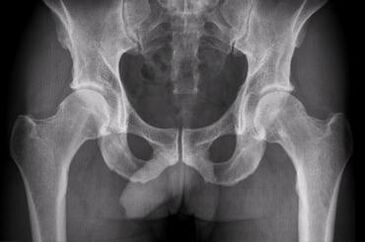
- In the third stage of the disease, the treatment involves surgery, in which the joints are replaced by endoprosthesis, while some of the prosthesis are imprisoned in the femur, and parts of the pelvis.The operation is quite complicated, long and requires a long recovery period.
- With degrees I and II hip joint arthrosis, treatment is performed without surgical intervention.Used: anti -medical medications, muscle relaxants, chondroprotectors, vasodilating drugs, hormone steroid drugs, local drugs, lotions, compress.
All of these medicines are prescribed exclusively by the attending physician.Some of them are effective in the form of direct injections to the affected articular region.Such injections can only be made by qualified medical staff.Therefore, self -medication is not recommended.
Non -Drug methods
In addition to the use of medicines, doctors recommend non -Drug methods to combat the disease.This includes the following methods of treating the disease:
- physiotherapy;
- Massage;
- joint reproduction;
- diet.
Physiotherapy used for arthrosis includes the following types of treatment:
- magnetotherapy;
- UHF and ultrasonic therapy;
- Aeroion and electrotherapy;
- inductothermia;
- phototherapy;
- The use of laser technology.
All of these methods can only be used to increase blood supply to the joints and relieve cramps.
Drug therapy
The combined treatment of hip arthrosis provides the appointment of the following drug group:
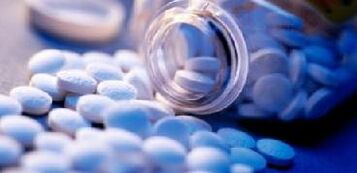
- Anti -Nonsteroidal Anti -Medicine, they all eliminate pain, relieve the inflammation process, but do not restore cartilage tissue.
- Chondroprotectors.Preparation for cartilage tissue nutrition.Accelerates his recovery.Important in 1.2 Phase of Arthrosis Treatment.With 3 degrees of disease, cartilage has been destroyed, these medicines are useless.You need to take the medication for a long time, taking several courses.
- MusorelaxantsEliminates muscle cramps in the joint area, contributing to increased blood supply.
- Ointment and cream.Therapeutic ointment is to reduce the condition of the sick, but does not contribute to complete recovery.Heating ointment is perfect.They stimulate skin receptors, and because of this they reduce the pain syndrome.Heating ointment also works to restore increased blood circulation in tissues and muscles located around the sore joints.
- Steroid injection to the joint cavity, injections of these medicines are prescribed to relieve the severity of the disease and to eliminate severe pain.
- Vasodilative medicine, expanding the vessel in the joint cavity and near it, thus increasing the delivery of the nutrients needed to restore tissue.
It does not have to depend on the treatment of the people.But some healers recommend the colors of lemon, garlic or celery root for the treatment of joints and bones.
Massage in the treatment of coxarthrosis
By seizing hip joint arthrosis, treatment with massage produces good results.Massage for coxarthrosis is a very effective and useful method.It is advisable that massage is done by a good specialist and as often as possible.
The effects are aimed at improving blood circulation, strengthening muscles, eliminating painful cramps, swelling and muscle tension, and increased diastasis between joint articulation.
In the absence of professional massage therapists, massage can be done on their own.Massage with arthrosis can be done manually and uses a variety of massage devices as well as jet water (hydrokinesotherapy).
Gymnastics
Treatment of hip joint arthrosis with physical education lies in achieving two tasks: to increase foot mobility and prevent muscle atrophy.All standard LFK complexes for coksartrosis also have general strengthening properties and positive effects on the entire organism.
Gymnastics training complexes are set by experts.The first pair of medical physical education should be done under the supervision of a doctor.He will show how to perform each movement correctly, and also control the right load on the hip joint.
Diet
The main suggestion:
- Give priority to porridge on water.
- Use sufficient amount of animal protein: fish (except salted), chicken, beef.
- Use at least 5 servings of vegetables -daily (one part -100 grams, can be used as a side dish).
- Mandatory dairy products: cottage cheese, yogurt, are fermented.
- Excludes alcohol, coffee, strong black tea.
- Excludes sweet flour.
- Eat a little, but often.
The diet will reduce the burden on the hip joint and give them everything they need to restore tissue.


















